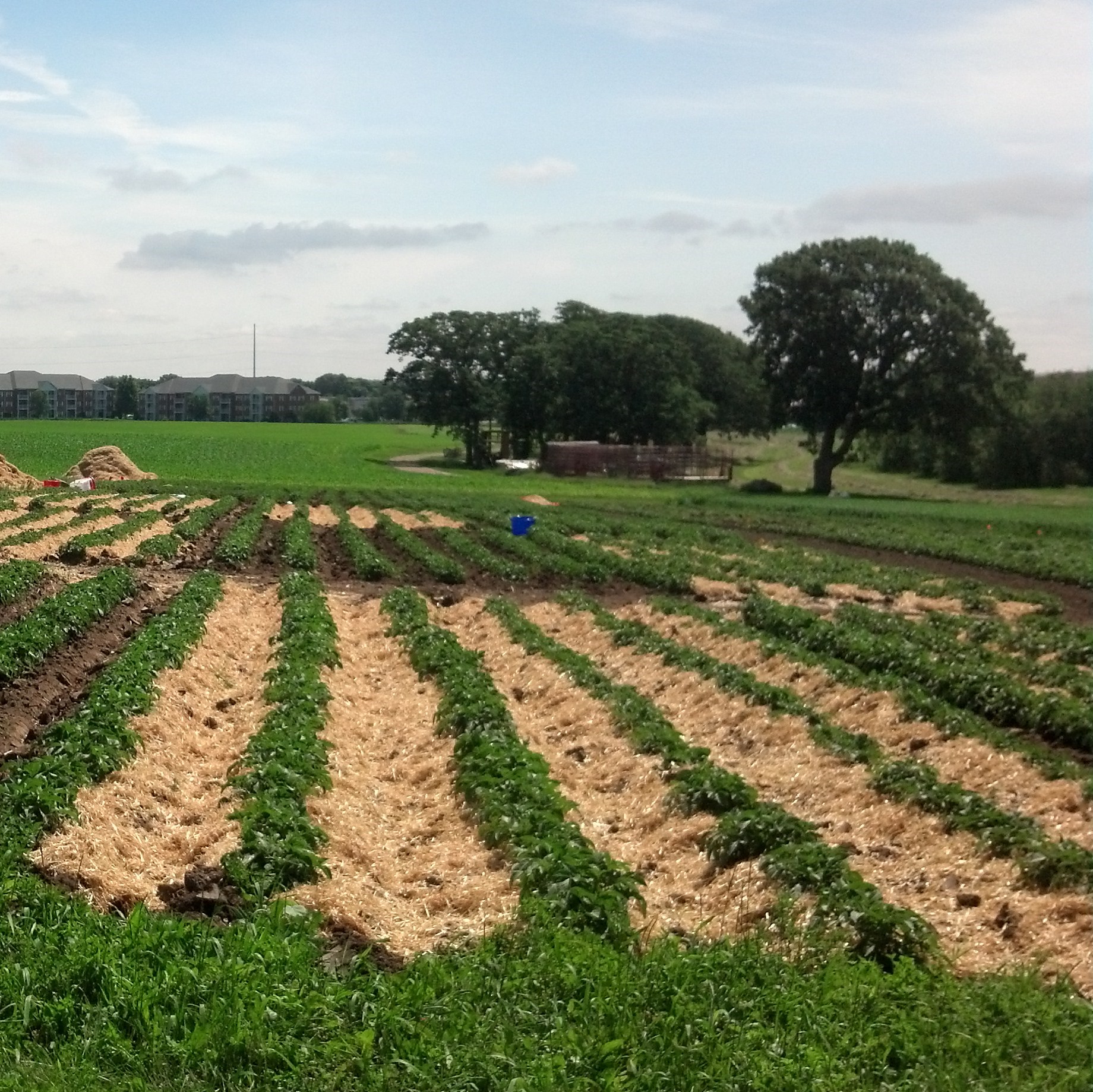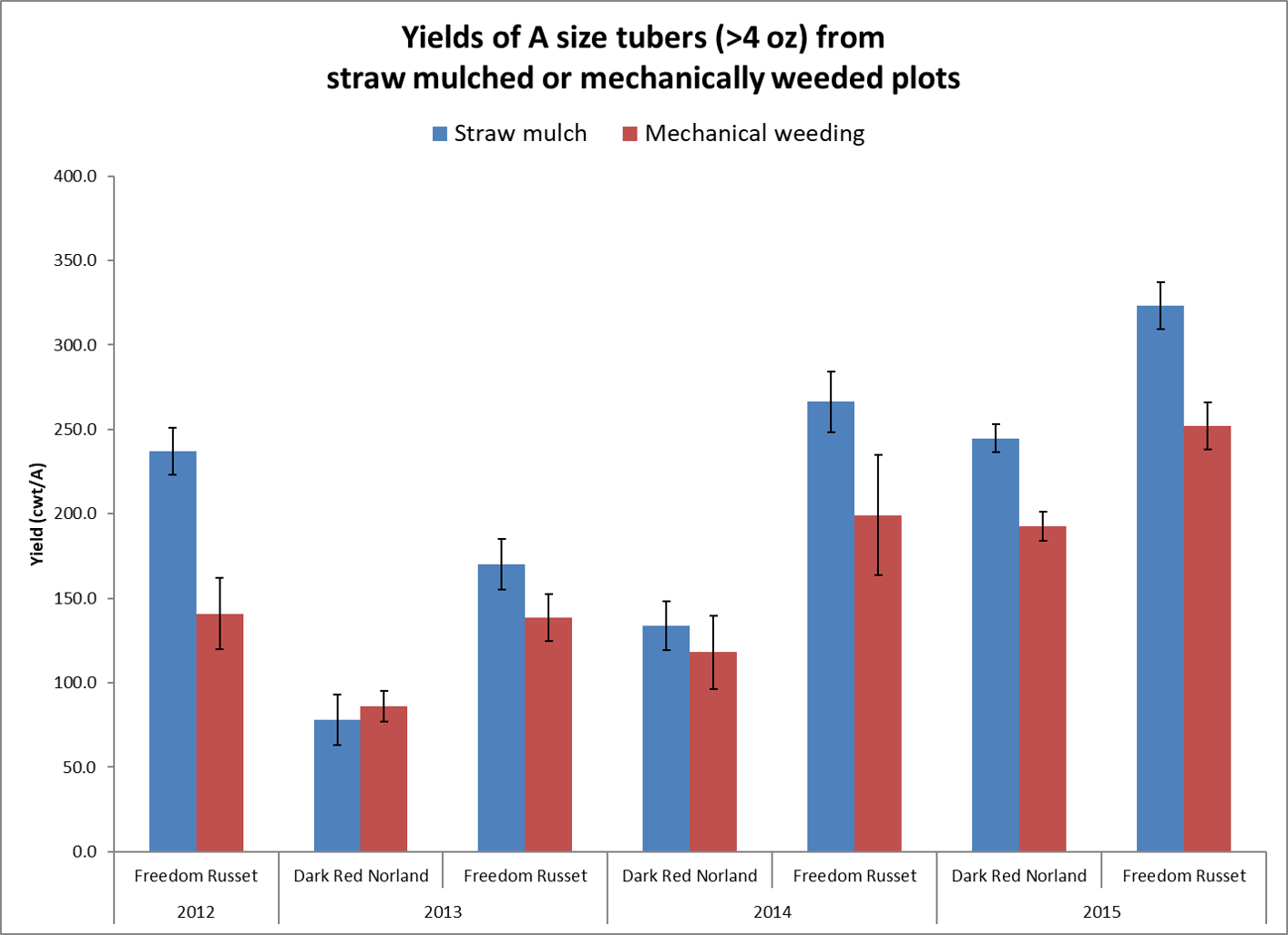Weeds are a challenge in any production system, and organic potatoes are no exception. Successful management requires multiple approaches including both long-term strategies such as crop rotation and cover cropping, and short-term remedies. In organic potato production, in-season weed management relies heavily on tillage. Through a collaboration with Wisconsin organic potato growers, University of Wisconsin researchers investigated an alternative strategy with potential benefits beyond weed suppression—mulching with straw.
 In trials at the West Madison Agricultural Research Station from 2012 to 2015, the researchers compared mechanical weed management by tine weeding and hilling with application of straw mulch at potato emergence. Straw mulch was more effective at suppressing broadleaf weeds during the growing season than mechanical weed control, while grass weed numbers were similar in straw-mulched and unmulched plots. Straw mulch made a real difference to weed management at vine senescence. As vines died back in unmulched plots, weeds began to emerge and rapidly set seeds, but in mulched plots, straw continued to suppress weed emergence, preventing a buildup of weed seeds in the soil.
In trials at the West Madison Agricultural Research Station from 2012 to 2015, the researchers compared mechanical weed management by tine weeding and hilling with application of straw mulch at potato emergence. Straw mulch was more effective at suppressing broadleaf weeds during the growing season than mechanical weed control, while grass weed numbers were similar in straw-mulched and unmulched plots. Straw mulch made a real difference to weed management at vine senescence. As vines died back in unmulched plots, weeds began to emerge and rapidly set seeds, but in mulched plots, straw continued to suppress weed emergence, preventing a buildup of weed seeds in the soil.
An exciting and unexpected benefit of straw mulching was a substantial increase in tuber yield. Increased tuber yields were seen consistently for the late-maturing Freedom Russet variety, and ranged from 23 to 34 percent increases in marketable yield. The early-maturing Dark Red Norland yielded similarly in mulched and unmulched plots, except in 2015 when marketable yields were 27 percent higher in mulched plots. For mulched plots of both varieties, the tuber size profile shifted toward larger tubers. Tubers from mulched plots tended to have lower incidence of tuber defect diseases including common scab and silver scurf, and lower incidence of greening.
Other research into straw-mulched potatoes has shown benefits beyond weed suppression and increased yields. It’s no surprise that straw mulch reduces soil erosion, and it also limits nitrate leaching after harvest. Several studies have shown that straw-mulching reduces plant defoliation by Colorado potato beetle larvae. Since straw provides habitat for beneficial predatory insects, reduced numbers of Colorado potato beetle larvae in straw-mulched plots are likely due to predation by these helpful, hungry insects. Straw mulch has also been shown to reduce incidence of aphid-transmitted potato virus Y—a reduction that is an obvious boon for seed potato producers.
Over the past two years, the research team has worked with seven Wisconsin organic vegetable farms to trial straw mulch in red, yellow, purple and fingerling potato varieties as well as in russets. Five participating growers noted higher yields in mulched plots compared to unmulched. At three of these farms, mulched plots yielded larger tubers than unmulched plots. Yields were similar for mulched and unmulched plots of two varieties at a sixth farm. At the final farm, mulched plots yielded poorly, probably due to mulch application too early in the season suppressing crop growth. Several growers noted better weed control under mulch, which, combined with higher yields, has convinced them to try mulching their potatoes on a larger scale in 2018.
 How does a grower decide whether mulching is worthwhile for his or her potato crop? One important consideration is economic, balancing input costs—straw and labor to apply it—against the benefits of reduced labor needs for later-season weed management and the potential of increased yields. High rates of straw application are more effective for weed suppression. In this study, researchers applied winter wheat straw at a rate of 10 tons per acre. For small square bales that weigh around 30 pounds apiece, that equates to around 670 bales per acre, or 15 bales for 100 square feet. Organic and specialty potatoes, with a higher profit margin, are more likely to repay the investment.
How does a grower decide whether mulching is worthwhile for his or her potato crop? One important consideration is economic, balancing input costs—straw and labor to apply it—against the benefits of reduced labor needs for later-season weed management and the potential of increased yields. High rates of straw application are more effective for weed suppression. In this study, researchers applied winter wheat straw at a rate of 10 tons per acre. For small square bales that weigh around 30 pounds apiece, that equates to around 670 bales per acre, or 15 bales for 100 square feet. Organic and specialty potatoes, with a higher profit margin, are more likely to repay the investment.
Correct timing of straw mulch application will suppress weeds while encouraging crop growth. Mulch application too early can keep soil cool, slowing crop emergence and canopy development. If straw is applied too late, when plants are more than 6 to 8 inches tall, it is difficult to achieve good mulch coverage around plants in the row, allowing weeds that emerge in the row to flourish. Ideally, growers should wait until the crop is fully emerged and apply mulch immediately after hilling. Good success has been seen using a flex tine cultivator consecutively with hilling to kill early-emerging weeds, followed by application of straw mulch.
It’s important to chop straw before application. Chopped straw provides better soil coverage and will pass through harvest machinery more easily. For small-scale growers, small square bales can be fed through a straw blower. Most of these machines are designed for use in landscaping or for spreading livestock bedding. Our preference is for models with a large-diameter hose to distribute straw along furrows and around plants in-row. The grinder/blower can be loaded onto a wagon along with a supply of straw bales. Larger-scale equipment capable of handling large square bales is used in ginseng production and perhaps may one day be modified for use in potato fields.
To avoid possible pitfalls, growers need to be sure to use clean straw with minimal weed seed contamination. It is also recommended to use straw from a winter grain such as winter wheat, so that if there is any grain remaining in the straw, resulting plants will stay vegetative.
Growers who want to see what benefits straw mulch might have for them can start with a small test area, and compare weeds and yields to their usual management strategies. Hopefully, growers will reap the same benefits seen in this Wisconsin study.